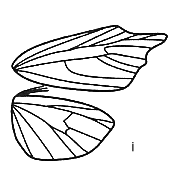|
Oxacme
Hampson
Type
species: dissimilis Hampson, N.E.
Himalaya (Fig 4i).

Fig 4i: Oxacme
dissimilis Hampson
Oxacme
is related
to Macaduma and Tortricosia as discussed above under Macaduma. The forewings tend to be the most apically acute of the
three genera, with a pale ground on which are delicately darker fasciae and
spots.
In
the male abdomen, the corematous structures invariably involve a conspicuous,
basally biarcuate supporting structure in segment 7 extending back into segment
6 (e.g. Figs 151, 316). The genitalia have the uncus much shorter than in Macaduma,
a slight, slender triangle. The valves are symmetrical, consisting of a
triple distal portion, weakly sclerotised, and a series of processes set more
basally, arising from the costa and the sacculus. The aedeagus vesica almost
always contains one large, slender cornutus. Two Bornean species have rather
more elongate, extensively sclerotised valves with reduced processes, and a more
elongate uncus shaped more like a hockey-stick.
 |
 |
The
female genitalia have general scobination in the bursa (Bornean species).
The
genus appears to be restricted to the Oriental tropics. In addition to the two
Himalayan species included by Hampson (dissimilis
and marginata Hampson) and the
Bornean species described below, it also includes O. cretacea Hampson comb. n. (Taiwan) and O.
commota van Eecke comb. n. (Sumatra).
<<Back
>>Forward <<Return
to Contents page
|



